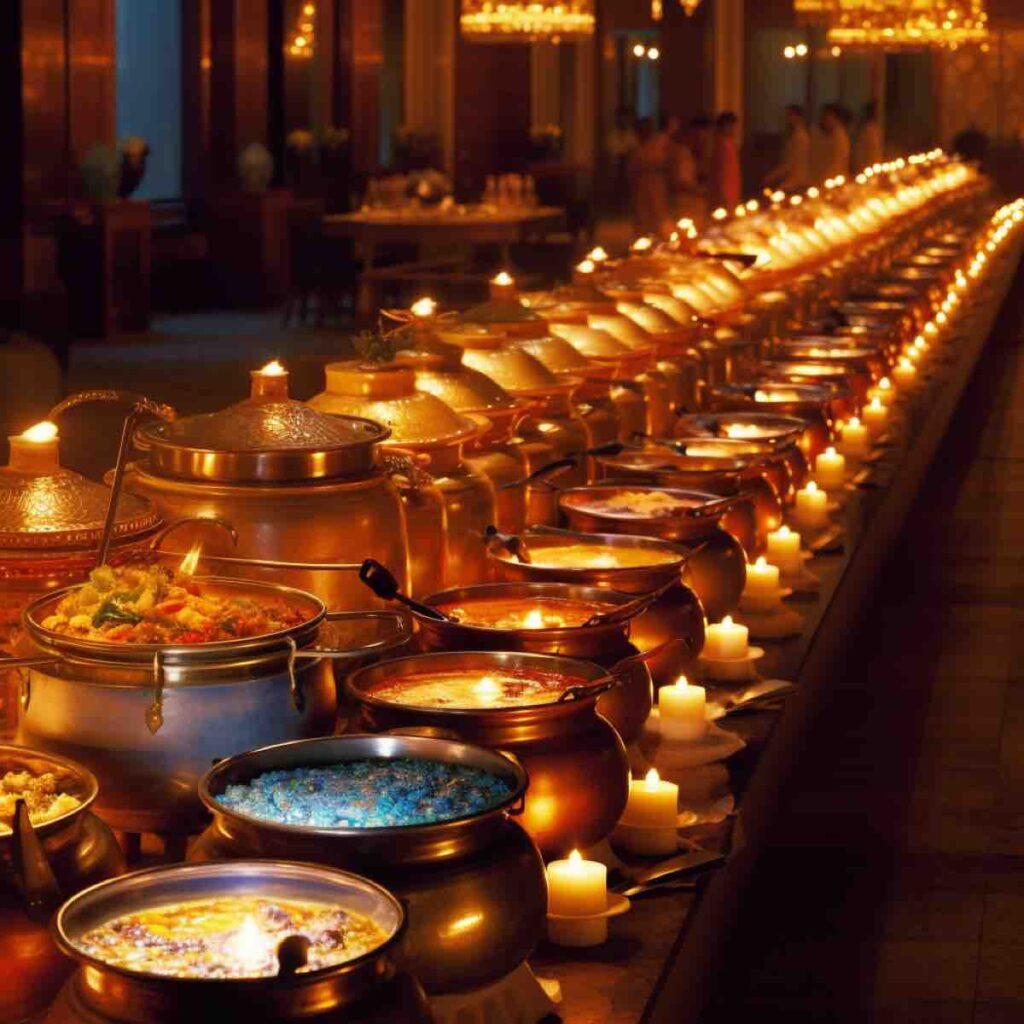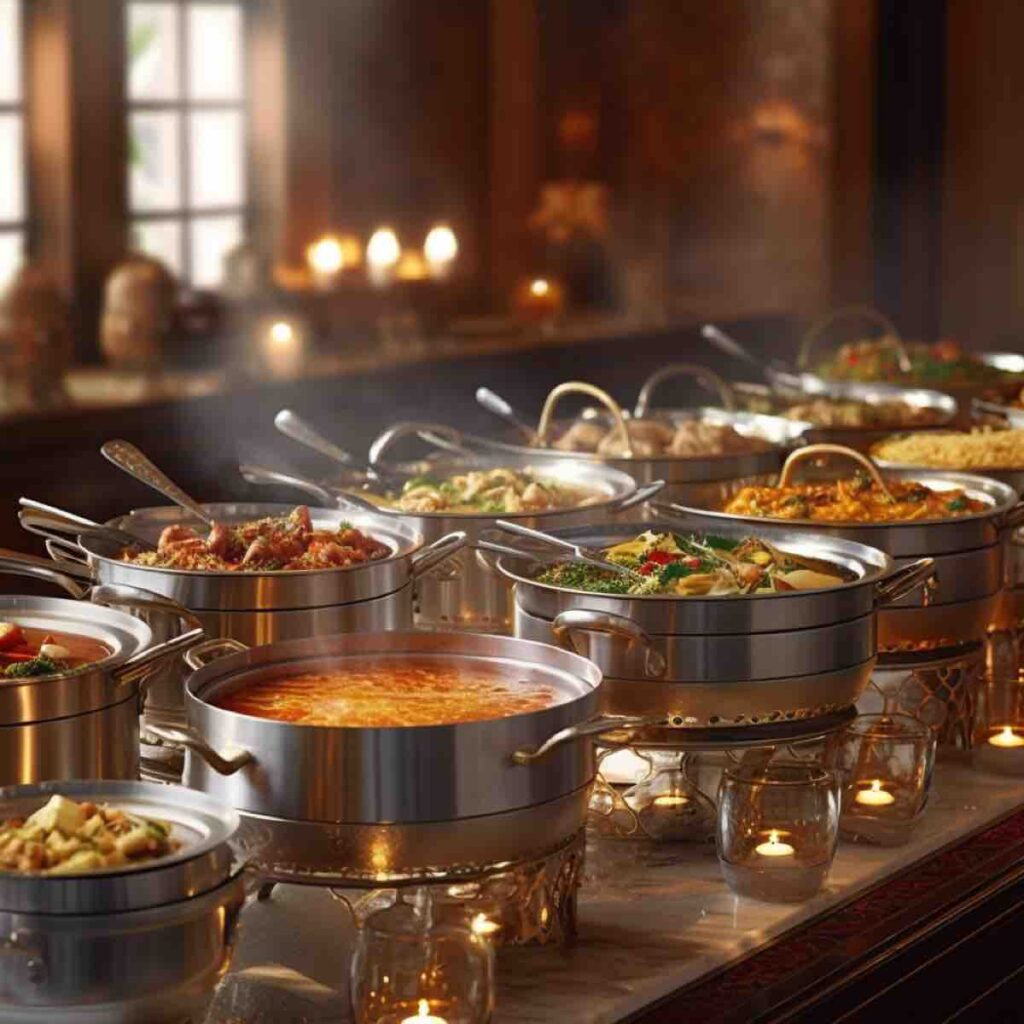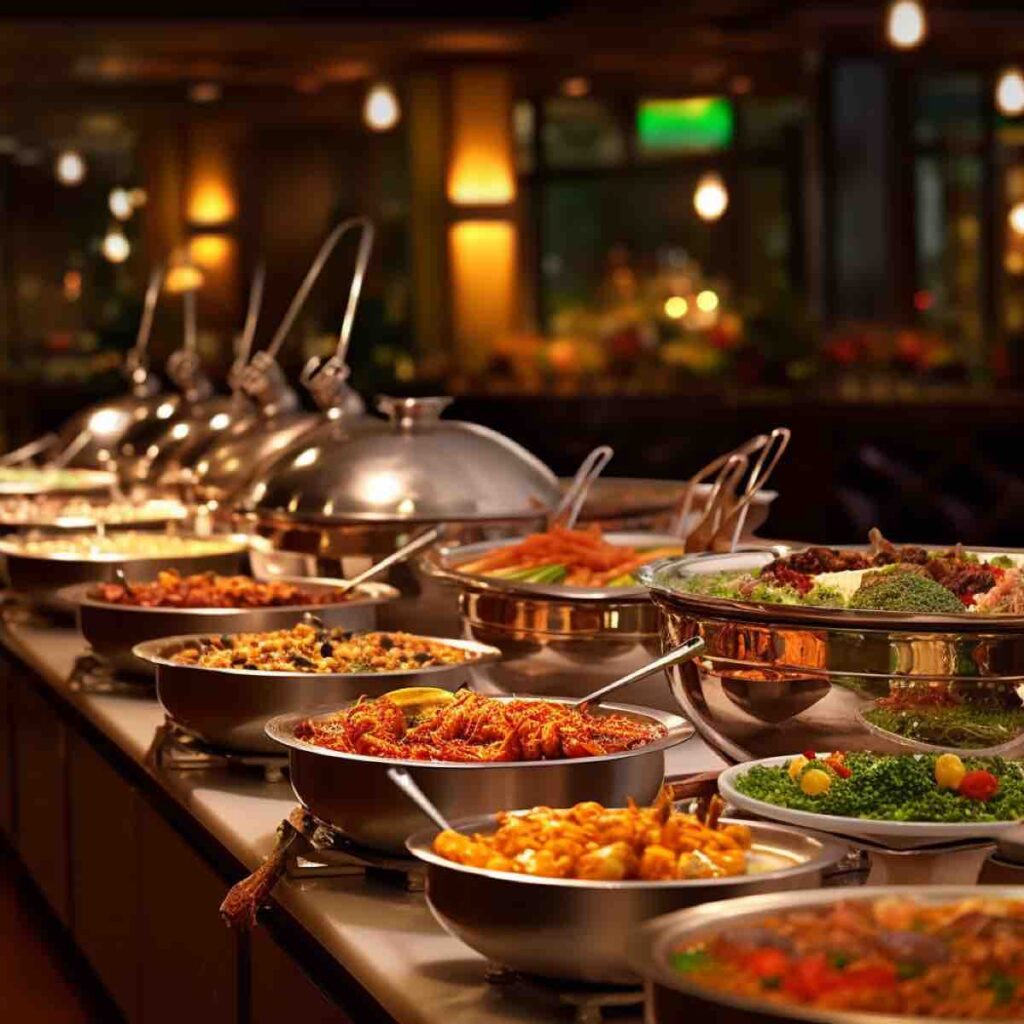How to Choose a Chafing Dish: Your Essential Guide
Choosing a chafing dish can be daunting, especially with the array of options available in the market.
Whether you’re hosting a backyard barbecue, an elegant Thanksgiving dinner, or an outdoor event at your banquet hall, having the right chafing dish can make all the difference.
But what exactly is a chafing dish? Let’s dive into the world of chafers and equip you with the knowledge you need to make an informed decision.
There are often used by professional caters to keep food warm.
We also have a separate article on transporting hot food to a picnic.
What is a Chafing Dish?
A chafing dish is more than just a piece of equipment; it’s essential for keeping food warm during any gathering or event.
The benefits of using a chafing dish range from maintaining food safety by keeping your meals at the right temperature to adding an elegant touch to your presentation. I mean, who does not want hot food?
They can also be used to keep rice warm and safe.
There are many types of chafers to consider, each serving a unique purpose and catering to different needs. Understanding what each type offers is key, bringing us to our next point.
–> Best Value Chafing Dish For Home Use [I really like This One – Affiliate Link]
Types of Chafers: Finding the Perfect Match
The type of chafer you choose depends on your specific needs and circumstances.
For example, electric chafers are great for indoor events with available electrical outlets. They provide a constant heat source, keeping your food hot without needing a fuel source or fuel cell holder.
On the other hand, induction chafers require induction-ready equipment but offer precise temperature control, making them perfect for delicate dishes that need to be kept at a specific temperature.
Disposable chafing dishes (Economy chafers) offer convenience for casual, one-time events. They’re ideal for outdoor events where cleaning up might be a challenge. Plus, the type of fuel used is typically gel fuel or wick fuel.
Traditional gel chafing dishes are a staple in many catering events and buffets, providing an elegant and efficient way to keep food warm. These dishes operate by using a gel fuel canister that is lit to provide heat (without electricity), which is then evenly distributed under the dish to keep the food at the optimal temperature.
The gel fuel is a great choice for chafing dishes as it burns cleanly, without producing any smoke or odor, and can maintain consistent heat for several hours.

Half-size chafers work well for smaller dishes or sides, while rectangular chafers are common for most main courses.
—> How To Clean a Chafing Dish Properly
In more specialized options, a Marmite chafer is designed for serving soups or sauces, and coffee and soup chafer urns are great for self-serve beverage stations. They can also be used for Hot Cereal, hot beverages, and even hot water.
For Coffee, you can get a specific Coffee Chaffer Urn.
One of the other primary decisions you’ll have to make when choosing a chafer type is whether you need a one-sided or two-sided service.
One-sided chafers are excellent for buffet lines against a wall, while two-sided chafers allow access from both sides, ideal for center-of-room buffet setups.
What is a One-Sided Chafer
A one-sided chafer, also known as a single-sided chafer, is a type of chafing dish designed to allow access from only one side – one-sided service. This style is typically used in buffet setups where the chafers are placed against a wall or a barrier.

The design of one-sided chafers restricts access to the food from the front side only, making it ideal for situations where control of the serving direction is necessary or when space is limited. They are usually employed in banquet halls, restaurants, and catering events where buffet lines are organized against walls. This arrangement helps guide guests in a single line, preventing crowding and confusion.
When choosing between a one-sided and two-sided chafer, consider your event’s layout and your guests’ convenience. If your buffet table is in the open with space on both sides, a two-sided chafer might be more suitable as it allows guests to access the food from both sides of the table.
What is a Two-Sided Chafer
A two-sided chafer, also known as a double-sided chafer, is a type of chafing dish that allows access to food from both sides, via hinged covers. Unlike the one-sided chafer that’s designed for buffet lines against a wall, the two-sided chafer is perfect for buffet tables situated in the center of a room or in an open space where guests can approach from either side.
Two-sided chafers often have a lid or cover that lifts from the center and folds down on both sides, providing an open path for guests to serve themselves from either direction. This design facilitates a smoother flow of people, reducing congestion and wait times at the buffet line, particularly for larger events.
When To Choose a One-sided or Two-Sided Chafer
Whether you should opt for a one-sided or two-sided chafer largely depends on the event’s layout, the number of guests, and the space available for the buffet setup. A two-sided chafer is especially beneficial when space isn’t an issue and you want to encourage a free-flowing, more dynamic movement of guests. As always, the primary goal is to keep your food hot while ensuring a smooth, enjoyable experience for your guests.

Heat Sources for Keeping Food Hot
Selecting a heat source for your oval chafing dish is just as crucial as choosing the dish itself. The heat source for fuel chafers ensures your food stays hot, and each type has pros and cons.
For full-sized chafing dishes you may need more than one fuel holder or fuel cans. I prefer to use gel chafing fuel as it is safer.
Traditional chafing fuel is readily available and relatively cheap, but it can be tricky to control the temperature.
Electric chafing dishes tend to offer better temperature control, but it requires an electrical outlet.
Induction heating or induction warmer provides the most precise temperature control but requires an induction chafer and range.
For a more detailed exploration of keeping food warm, be sure to check out [this article](https://onepotdishrecipe.com/how-do-professional-caterers-keep-food-warm/) on how professional caterers keep food warm.
What Sizes Do Chafing Dishes Come In?
Chafing dishes, also referred to as chafers, come in several sizes to accommodate different catering requirements. The most commonly encountered sizes are full-size and half-size chafers.
A full-size chafer, as the name suggests, is considered the standard size for many catering activities. A typical full-size chafer measures approximately 20.75″ in length by 12.75″ in width, although this can vary. Full-size chafing dishes are flexible and can be used to serve a wide variety of dishes. They typically contain a full-size food pan and can hold a substantial amount of food. In terms of capacity, a full-size water pan usually holds around 8-9 quarts of food, making it ideal for larger gatherings or events.
Half-size chafers, meanwhile, are roughly half the size of a full-size chafer. They are perfect for serving smaller portions, side dishes, or for providing variety in a buffet setup where multiple food options are desired. As the name suggests, a half-size chafer contains a half-size food pan.
There’s also a 2/3-size range, which offers a middle ground between full-size and half-size chafers. These can be handy when you need a size larger than a half-size chafer, but smaller than a full-size one.
Keep in mind that chafers can also be found in different shapes. Rectangular is the most common, but round and oval shapes are available too. The chafer size you need will ultimately depend on the type and volume of food you’re serving, the number of guests, and the layout of your buffet setup.
By considering your needs and the various dish sizes available, you can choose the size dishes and chafer sizes that are most suitable for your event, ensuring the food remains warm and appealing for all your guests. For instance, if you’re looking for tips on how to keep pulled pork warm for a party, a chafer can be an excellent choice.
Determining the number of chafing dishes needed for an event can be influenced by several factors, including the variety of dishes being served, the duration of the event, and the guests’ eating habits. A general rule of thumb used by many professional caterers is one full-size chafer for every 20-25 guests when serving a main dish.
That being said, if you’re offering a wider selection of dishes or if your event spans a longer period, you might want to consider having more chafers to accommodate. For smaller events, half-size chafers can be an excellent choice as well.
How Many Chafing Dishes Do I Need For A Big Group
For 10 people: 1 full-size chafer for a main dish, supplemented with 1-2 half-size chafers for sides or variety.
For 20 people: 1-2 full-size chafers for main dishes, supplemented with 2-3 half-size chafers for sides or variety.
For 50 people: 2-3 full-size chafers for main dishes, supplemented with 4-5 half-size chafers for sides or variety.
For 150 people: 6-8 full-size chafers for main dishes, supplemented with 10-12 half-size chafers for sides or variety.
For 200 people: 8-10 full-size chafers for main dishes, supplemented with 15-20 half-size chafers for sides or variety.
Here’s a summarizing table:
| Number of Guests | Full-Size Chafers (Main Dishes) | Half-Size Chafers (Sides/Variety) |
|---|---|---|
| 10 | 1 | 1-2 |
| 20 | 1-2 | 2-3 |
| 50 | 2-3 | 4-5 |
| 150 | 6-8 | 10-12 |
| 200 | 8-10 | 15-20 |
Remember, these are just estimates, and the exact number will depend on the specific details of your event. It’s always better to have slightly more than less to ensure everyone enjoys their meal hot and delicious.
How to Separate Chafing Dishes
Separating chafing dishes is essential for food presentation and maintaining food temperature and preventing potential cross-contamination. Here are some tips on how to effectively separate your chafing dishes:
- Space Appropriately: Leave enough space between each chafer to prevent accidental spills or cross-contamination. This gap will also make it easier for guests to serve themselves without interfering with other dishes.
- Group Similar Dishes Together: Arrange dishes that go together next to each other, such as a main dish and its accompanying sides. This arrangement helps facilitate a smoother buffet line.
- Use Barriers: Consider using decorative barriers or stands to elevate some dishes or to create physical separation. This can help when you have dishes that might interfere with each other, like spicy foods and mild ones.
- Consider Traffic Flow: Consider the order of the dishes from the perspective of a guest walking through the line. Start with plates at one end, followed by main dishes, sides, and then end with utensils and napkins.
- Label Dishes: Use name tags or markers to label each dish, especially when serving to a diverse group with potential food allergies or dietary restrictions. This way, everyone can easily identify what’s in each chafer.
- Temperature Control: Separate dishes based on their required heat levels. Some chafers might need to be hotter for certain dishes, and separating these from cooler ones can help maintain appropriate temperatures.
Remember, the ultimate goal is to create a seamless dining experience for your guests, and a well-planned buffet setup can contribute significantly towards this objective.